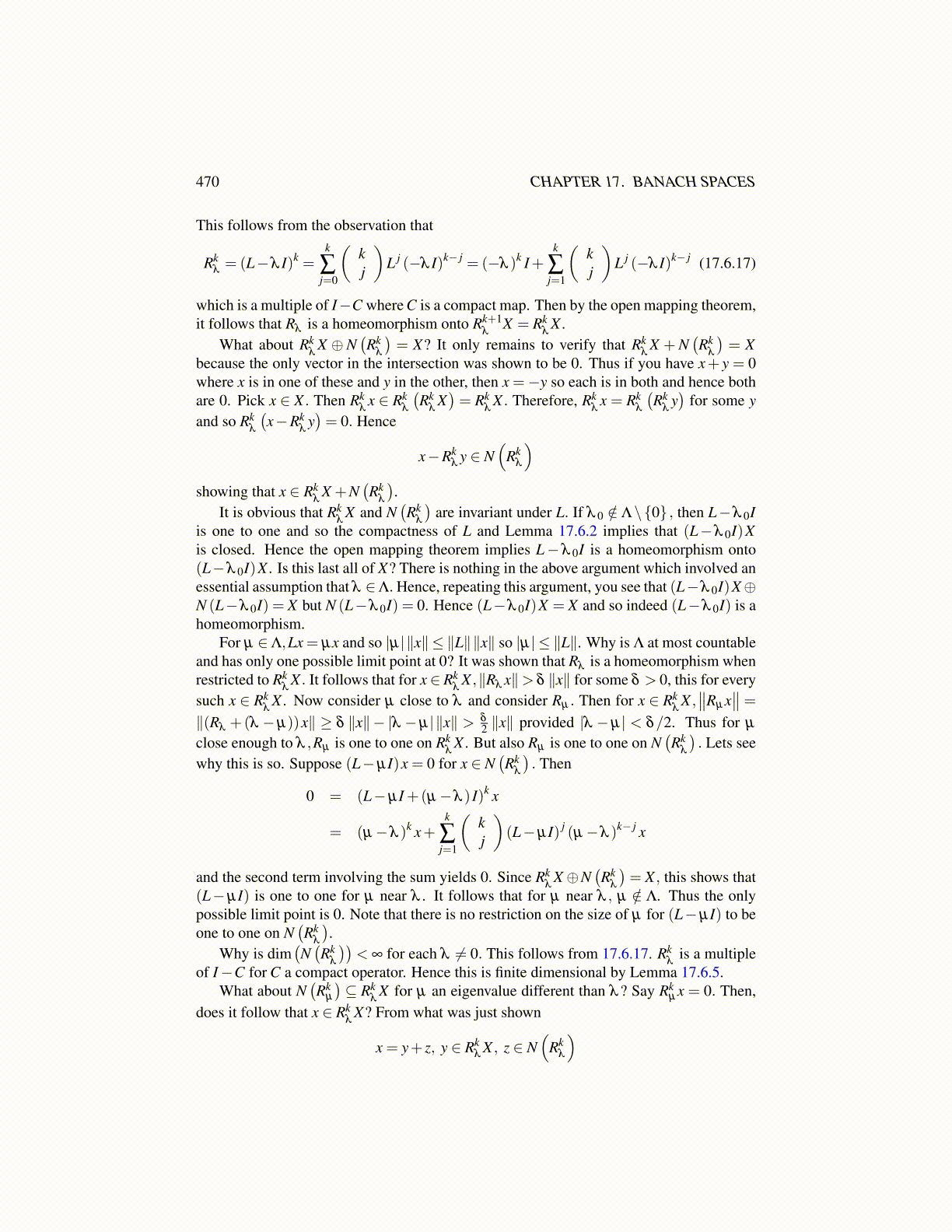
470 CHAPTER 17. BANACH SPACES
This follows from the observation that
Rkλ= (L−λ I)k =
k
∑j=0
(kj
)L j (−λ I)k− j = (−λ )k I+
k
∑j=1
(kj
)L j (−λ I)k− j (17.6.17)
which is a multiple of I−C where C is a compact map. Then by the open mapping theorem,it follows that Rλ is a homeomorphism onto Rk+1
λX = Rk
λX .
What about Rkλ
X ⊕N(Rk
λ
)= X? It only remains to verify that Rk
λX + N
(Rk
λ
)= X
because the only vector in the intersection was shown to be 0. Thus if you have x+ y = 0where x is in one of these and y in the other, then x =−y so each is in both and hence bothare 0. Pick x ∈ X . Then Rk
λx ∈ Rk
λ
(Rk
λX)= Rk
λX . Therefore, Rk
λx = Rk
λ
(Rk
λy)
for some yand so Rk
λ
(x−Rk
λy)= 0. Hence
x−Rkλ
y ∈ N(
Rkλ
)showing that x ∈ Rk
λX +N
(Rk
λ
).
It is obvious that Rkλ
X and N(Rk
λ
)are invariant under L. If λ 0 /∈ Λ\{0} , then L−λ 0I
is one to one and so the compactness of L and Lemma 17.6.2 implies that (L−λ 0I)Xis closed. Hence the open mapping theorem implies L− λ 0I is a homeomorphism onto(L−λ 0I)X . Is this last all of X? There is nothing in the above argument which involved anessential assumption that λ ∈Λ. Hence, repeating this argument, you see that (L−λ 0I)X⊕N (L−λ 0I) = X but N (L−λ 0I) = 0. Hence (L−λ 0I)X = X and so indeed (L−λ 0I) is ahomeomorphism.
For µ ∈Λ,Lx = µx and so |µ|∥x∥ ≤ ∥L∥∥x∥ so |µ| ≤ ∥L∥. Why is Λ at most countableand has only one possible limit point at 0? It was shown that Rλ is a homeomorphism whenrestricted to Rk
λX . It follows that for x ∈ Rk
λX ,∥Rλ x∥> δ ∥x∥ for some δ > 0, this for every
such x ∈ Rkλ
X . Now consider µ close to λ and consider Rµ . Then for x ∈ Rkλ
X ,∥∥Rµ x
∥∥ =∥(Rλ +(λ −µ))x∥ ≥ δ ∥x∥− |λ −µ|∥x∥ > δ
2 ∥x∥ provided |λ −µ| < δ/2. Thus for µ
close enough to λ ,Rµ is one to one on Rkλ
X . But also Rµ is one to one on N(Rk
λ
). Lets see
why this is so. Suppose (L−µI)x = 0 for x ∈ N(Rk
λ
). Then
0 = (L−µI +(µ−λ ) I)k x
= (µ−λ )k x+k
∑j=1
(kj
)(L−µI) j (µ−λ )k− j x
and the second term involving the sum yields 0. Since Rkλ
X ⊕N(Rk
λ
)= X , this shows that
(L−µI) is one to one for µ near λ . It follows that for µ near λ , µ /∈ Λ. Thus the onlypossible limit point is 0. Note that there is no restriction on the size of µ for (L−µI) to beone to one on N
(Rk
λ
).
Why is dim(N(Rk
λ
))< ∞ for each λ ̸= 0. This follows from 17.6.17. Rk
λis a multiple
of I−C for C a compact operator. Hence this is finite dimensional by Lemma 17.6.5.What about N
(Rk
µ
)⊆ Rk
λX for µ an eigenvalue different than λ? Say Rk
µ x = 0. Then,does it follow that x ∈ Rk
λX? From what was just shown
x = y+ z, y ∈ Rkλ
X , z ∈ N(
Rkλ
)